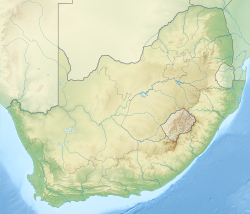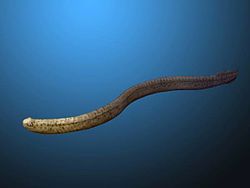| Soom Shale | |
|---|---|
| Stratigraphic range: Hirnantian | |
 Typical lithological features of the Soom shale, note the frequent beds of white quartz | |
| Unit of | Cederberg Formation, Table Mountain Group |
| Underlies | Disa Siltstone |
| Overlies | Pakhuis Tillite |
| Thickness | 10–15 m (33–49 ft) |
| Lithology | |
| Primary | Shale |
| Location | |
| Coordinates | 33°00′S19°00′E / 33.0°S 19.0°E |
| Approximate paleocoordinates | 28°30′S153°42′E / 28.5°S 153.7°E |
| Region | Western Cape |
| Country | South Africa |
The Soom Shale is a member of the Late Ordovician (Hirnantian) Cederberg Formation (Table Mountain Group) in South Africa, renowned for its remarkable preservation of soft-tissue in fossil material. [1] Deposited in still waters, the unit lacks bioturbation, perhaps indicating anoxic conditions. [1]
Contents
It overlies the Pakhuis tillite and is overlain by the Disa Siltstone. [1]
It contains typical Ordovician microfossils, such as chitinozoa, acritarchs and spores, and its shelly fauna is also typical of this time period. [1]
Its macrofauna comprises pelagic organisms that sank rapidly to a barren sea floor. [2] These include brachiopods, [3] eurypterids, conodonts, [4] nektaspids, trilobites, a lobopodian [5] and orthoconic cephalopods.




